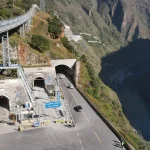Scientists have made a significant finding that challenges our current knowledge of Mars’s water reserves. They have discovered an enormous subterranean ice deposit that extends an astonishing depth of two miles. Located within the Medusae Fossae Formation, this concealed sanctuary contains a sufficient amount of water to cover the entire globe with a vast ocean ranging from 1.5 to 2.7 meters in depth.
The revelation, achieved through the analysis of data collected by the Mars Express spacecraft of the European Space Agency, signifies a significant milestone in the study of Mars. The ice deposits within the reservoir, appropriately referred to as the Korolev Crater Ice Lens, surpass the size of any previously discovered ice formations on Mars. The large amount of data raises intriguing inquiries regarding the history of Mars and the possibilities for future human expeditions.
“This is a significant breakthrough,” stated Francesco Nerlich, the primary author of the study published in Nature Astronomy. “The findings indicate a significantly greater presence of water on Mars than previously conceived, and its accessibility surpasses previous assumptions.”
The formation of the Korolev Crater Ice Lens dates back billions of years, originating from the accumulation of water ice, possibly derived from historical snow and icefalls on Mars. This ice filled the crater and was eventually covered by volcanic ash and dust. Over a period of time, the combination of pressure and heat caused the ice to become compressed, resulting in a layer that is two miles deep and has a high density.
The ramifications of this revelation are extensive. The existence of a substantial water reservoir on Mars implies that the planet may have once possessed a significantly higher amount of water, perhaps creating an environment conducive to supporting life. Moreover, the conveniently obtainable ice could function as a vital asset for forthcoming human expeditions to Mars, offering astronauts potable water, irrigation for cultivating sustenance, and perhaps propellant for rocket propulsion.
“The revelation presents a fresh phase in our comprehension of Mars,” stated Lori Glaze, the head of NASA’s Planetary Science Division. “It enhances our comprehension of the planet’s historical background and the possibility of extraterrestrial life.” Furthermore, this development enhances the appeal of Mars as a prospective target for forthcoming human exploration.
Scientists are currently enthusiastic about acquiring further knowledge regarding the Korolev Crater Ice Lens. Potential future expeditions may deploy rovers or even human explorers to directly examine the ice, assess its composition, and investigate for indications of ancient microbial life.
The identification of this water-rich region on Mars is a clear demonstration of the persistent human desire for exploration and the pursuit of new knowledge. It serves as a reminder that within the expansive void of space, there exist undiscovered marvels yet to be revealed. As we further explore the mysteries of Mars, it is evident that the Red Planet is no longer devoid of life and resources but rather a planet teeming with opportunities and prospects.
This revelation is certain to intensify interest in exploring Mars for many years to come. With every new disclosure, we make gradual progress toward resolving the timeless inquiry: do we exist in solitude inside the cosmos? Potentially, the solution could be concealed beneath the subterranean layer of Mars, patiently awaiting discovery.








